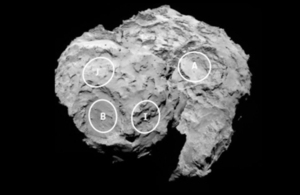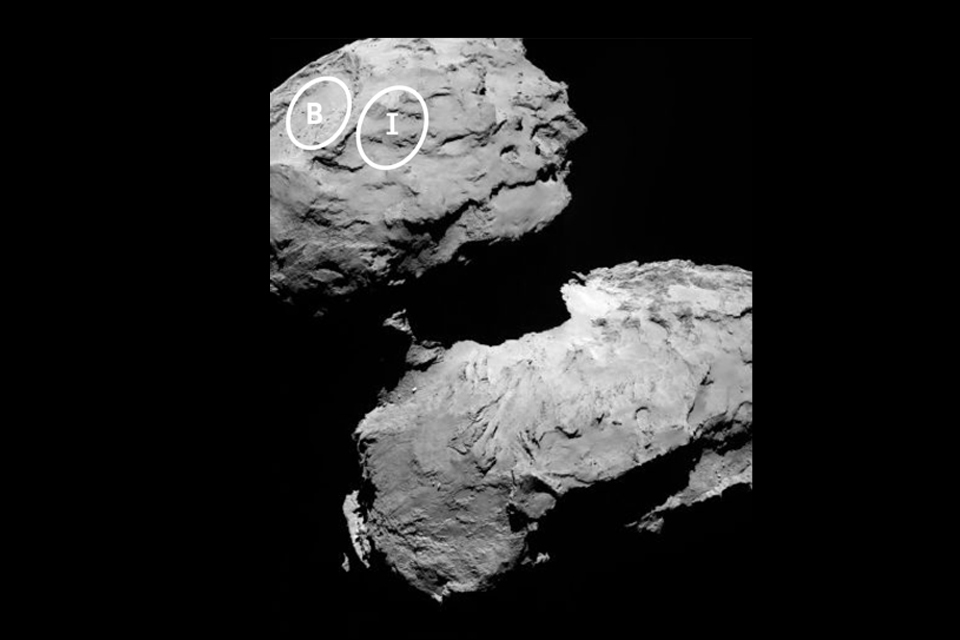Rosetta: landing site search narrows
Five locations identified as candidate sites to set down Rosetta's Philae lander in November.

Philae candidate landing sites. Credit: ESA/Rosetta/MPS for OSIRIS Team MPS/UPD/LAM/IAA/SSO/INTA/UPM/DASP/IDA.
Using detailed information collected by Europe’s Rosetta spacecraft during its first 2 weeks at Comet 67P/Churyumov-Gerasimenko, 5 locations have been identified as candidate sites to set down the Philae lander in November – the first time a landing on a comet has ever been attempted.
Before arrival, Comet 67P/Churyumov-Gerasimenko had never been seen close up and so the race to find a suitable landing site for the 100 kg lander could only begin when Rosetta rendezvoused with the comet on 6 August.
The landing is expected to take place in mid-November when the comet is about 450 million km from the Sun, before activity on the comet reaches levels that might jeopardise the safe and accurate deployment of Philae to the comet’s surface, and before surface material is modified by this activity.

Philae candidate landing sites. Credit: ESA/Rosetta/MPS for OSIRIS Team MPS/UPD/LAM/IAA/SSO/INTA/UPM/DASP/IDA.
The comet is on a 6.5-year orbit around the Sun and today is 522 million km from it. At their closest approach on 13 August 2015, just under a year from now, the comet and Rosetta will be 185 million km from the Sun, meaning an eightfold increase in the light received from the Sun.
While Rosetta and its scientific instruments will watch how the comet evolves as heating by the Sun increases, observing how its coma develops and how the surface changes over time, the lander Philae and its instruments will be tasked with making complementary in situ measurements at the comet’s surface. The lander and orbiter will also work together using the CONSERT experiment to send and detect radio waves through the comet’s interior, in order to characterise its internal structure.
Choosing the right landing site is a complex process. That site must balance the technical needs of the orbiter and lander during all phases of the separation, descent, and landing, and during operations on the surface with the scientific requirements of the 10 instruments on board Philae.
A key issue is that uncertainties in the navigation of the orbiter close to the comet mean that it is only possible to specify any given landing zone in terms of an ellipse – covering up to one square kilometre – within which Philae might land.
For each possible zone, important questions must be asked: Will the lander be able to maintain regular communications with Rosetta? How common are surface hazards such as large boulders, deep crevasses or steep slopes? Is there sufficient illumination for scientific operations and enough sunlight to recharge the lander’s batteries beyond its initial 64-hour lifetime, while not so much as to cause overheating?

Philae candidate landing sites. Credit: ESA/Rosetta/MPS for OSIRIS Team MPS/UPD/LAM/IAA/SSO/INTA/UPM/DASP/IDA.
To answer these questions, data acquired by Rosetta from about 100 km distance have been used, including high-resolution images of the surface, measurements of the comet’s surface temperature, and the pressure and density of gas around the nucleus. In addition, measurements of the comet’s orientation with respect to the Sun, its rotation, mass and surface gravity have been determined. All of these factors influence the technical feasibility of landing at any specific location on the comet.
This weekend, the Landing Site Selection Group (comprising engineers and scientists from Philae’s Science, Operations and Navigation Centre at CNES, the Lander Control Centre at DLR, scientists representing the Philae Lander instruments and ESA’s Rosetta team) met at CNES, Toulouse, to consider the available data and determine a shortlist of five candidate sites.
The sites were assigned a letter from an original pre-selection of 10 possible sites, which does not signify any ranking. Three sites (B, I and J) are located on the smaller of the two lobes of the comet and two sites (A and C) are located on the larger lobe.
Summary of the five candidate sites
Site A
Site A is an interesting region located on the larger lobe, but with a good view of the smaller lobe. The terrain between the two lobes is likely the source of some outgassing. Higher-resolution imaging is needed to study potential surface hazards such as small depressions and slopes, while the illumination conditions also need to be considered further.
Site B
Site B, within the crater-like structure on the smaller lobe, has a flat terrain and is thus considered relatively safe for landing, but illumination conditions may pose a problem when considering the longer-term science planning of Philae. Higher-resolution imaging will be needed to assess the boulder hazards in more detail. In addition, the boulders are also thought to represent more recently processed material and therefore this site may not be as pristine as some of the others.
Site C
Site C is located on the larger lobe and hosts a range of surface features including some brighter material, depressions, cliffs, hills and smooth plains, but higher-resolution imaging is needed to assess the risk of some of these features. It is also well illuminated, which would benefit the long-term scientific planning for Philae.
Site I
Site I is a relatively flat area on the smaller lobe that may contain some fresh material, but higher-resolution imaging is needed to assess the extent of the rough terrain. The illumination conditions should also allow for longer-term science planning.
Site J
Site J is similar to site I, and also on the smaller lobe, offering interesting surface features and good illumination. It offers advantages for the CONSERT experiment compared with Site I, but higher-resolution imaging is needed to determine the details of the terrain, which shows some boulders and terracing.
The next step is a comprehensive analysis of each of the candidate sites, to determine possible orbital and operational strategies that could be used for Rosetta to deliver the lander to any of them. At the same time, Rosetta will move to within 50 km of the comet, allowing a more detailed study of the proposed landing sites.
By 14 September, the five candidate sites will have been assessed and ranked, leading to the selection of a primary landing site, for which a fully detailed strategy for the landing operations will be developed, along with a backup.
During this phase, Rosetta will move to within 20–30 km of the comet, allowing even more detailed maps of the boulder distributions at the primary and backup landing sites to be made. This information could be important in deciding whether to switch from primary to backup.
The Rosetta mission team are working towards a nominal landing date of 11 November, but confirmation of the primary landing site and the date will likely only come on 12 October. This will be followed by a formal Go/No Go from ESA, in agreement with the lander team, after a comprehensive readiness review on 14 October.
Rosetta and the UK
With funding from the UK Space Agency, Rosetta is a mission with significant UK involvement. UK scientists are involved in ten of the 21 experiments that Rosetta will carry out during its mission:
- the Open University is leading the team for the Ptolemy instrument on the lander
- Armagh Observatory will be helping to analyse the results from the OSIRIS instrument
- Imperial College London and University College London’s Mullard Space Science Laboratory (MSSL) supply the team studying the comet’s plasma
- scientists at Oxford University are part of the science team for VIRTIS
- Queen Mary College at the University of London will be investigating the results of the CONSERT instrument
Industry involvement
The following UK companies have been involved in the mission:
- Airbus Defence and Space, based in Stevenage, was the major subcontractor for the Rosetta platform
- the Science & Technology Facilities Council (STFC) Rutherford Appleton Laboratory managed to reduce a lab full of chemistry equipment to enable it to fit into a space the size of a shoebox
- SciSys UK Ltd is responsible for the spacecraft Mission Control System development and maintenance; in recognition of this work on the Rosetta and the Beagle 2 missions, SciSys were awarded the title of “Innovator of the Year” by the UK Computing Awards for Excellence 2004
- VEGA Group plc was involved in many aspects of the Rosetta mission, from the overall design of the spacecraft to the on board software technology created by Logica (now CGI) helped to explore some of the issues involved in such a long mission, the company was also involved in the development of the Rosetta on board software
- AEA Battery Systems Limited provided innovative batteries for the spacecraft and lander. These are smaller, lighter and much more reliable than the traditional nickel-cadmium batteries
- AEA Technology, European Space Tribology Laboratory (ESTL) developed the Micro-Imaging Dust Analysis System (MIDAS)
- Polyflex Space Ltd provided tanks to store the helium used by the lander
- Surrey Satellite Technology Limited (SSTL) designed a wheel that will stabilise the probe as it descends and lands on the comet